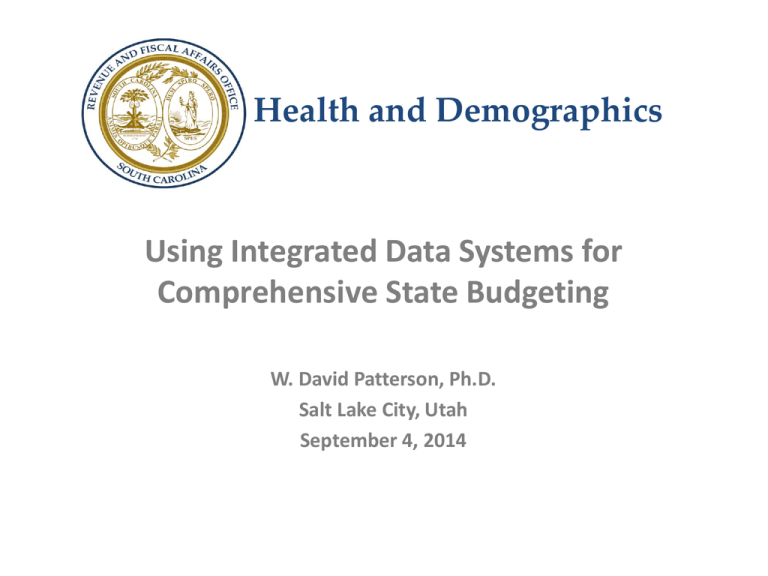(Integrated Data Systems). - National Association of State Budget
advertisement

Health and Demographics Using Integrated Data Systems for Comprehensive State Budgeting W. David Patterson, Ph.D. Salt Lake City, Utah September 4, 2014 ACTIONABLE INTELLIGENCE FOR SOCIAL POLICY AISP Network of Integrated Data Systems ISP 22% of the U.S. Population A MacArthur-Funded Initiative Integrating Data To Improve Services Education Justice Child Welfare Employment And Earnings Housing Health Care Disabilities Mental Health Public Safety 4 CLOSING THE GAP: Multi-system Populations & Developmental Handoffs Identify & lessen risks to poor outcomes Improve the QUALITY of Education, Health, & Human Services Connect Communities to support populations 5 Who are we? • Mission: “It is the entire human experience that influences health and social well-being and should therefore be captured in an integrated data system.” • Staff: 35 employees, 2/3 statisticians trained in either theoretical statistics or their substantive disciplines. The remaining staff are focused on supporting information/knowledge deployment skills such as software development and data base administration, or business operations. • Budget: Roughly $6m annually, with less than 15% through general appropriations or assigned fees. Evolution of the Data Warehouse • Philosophy developed over time and experience eventually becoming a recognized example nationally. • Characteristics of a successful data warehouse: o Data must be housed in a neutral setting o Data holder can not be a regulator, payer, or provider of services o Data holder can have no power base, can not upset balance of power o Provides equal access for all users o Promotes research and use o Data must be secured and individual privacy protected o Data release must be approved by data owner or by multistakeholder councils and committees Proviso 117.13. (GP: SC Health & Human Services Data Warehouse) “There is hereby established within the Office of Research and Statistics, South Carolina Budget and Control Board, the South Carolina Health and Human Services Data Warehouse. The purpose of the Warehouse is to ensure that the operation of health and human services agencies may be enhanced by coordination and integration of client information. To integrate client information, client data from health and human services state agencies will be linked to improve client outcome measures, enabling state agencies to analyze coordination and continuity of care issues. The addition of these data will enhance existing agency systems by providing client data from other state agency programs to assist in the provision of client services. Certain client information shall be delivered to the Office of Research and Statistics in order to assist in the development and maintenance of this Warehouse…” Elder Services & Assessments Employment & Wage Disabilities & Special Needs Vocational Rehabilitation Homeless MIS* SLED Employment Training Programs Unemployment Claims Legal/Safety Services Juvenile Justice Social Services Probation, Parole & Pardon Claims Systems Corrections Education LEGEND All Payer Health Care Databases Health Professions Social Services First Steps Behavioral Health Health Department Alcohol & Drug Services Disease Registries* Mental Health State Employee Health Services Health Professions Home Health Care Emergency Room Visits Child Care Medicaid Services Free Clinic Visits* Outpatient Surgeries Hospitalizations Community Health Centers* Health Department Education Employment and Workforce Disease Registries Other State Agencies * Limited data available Tracking System • Series of algorithms to create a unique identifier for each individual • Unique identifier stays with the individual over time • Enables staff to “link across” multiple providers and settings • Protects the confidentiality of the individual • Requests to link across systems must be approved by all participating agencies and organizations Personal identifiers are never stored with the statistical data; the unique identifier is appended to the statistical record and is not derived from identifiable information. Information Products Analytic Products • Agency Collaboration • Researcher Collaboration o o o o Data linkage De-identified datasets GIS support Analytic support • Public Website o Descriptive statistics o Ability to query data sources and generate ad-hoc reports • • • • • • Application Partners ABC Tablet Application Community Long Term Care Application Ages and Stages Questionnaire Dept. of Education Data Warehouse Purpose Built Screening and Referral Systems South Carolina Health Information Exchange Example 1: Health Care Price Transparency Example 2: Telepsychiatry Program Support and Evaluation Roles of the Data Warehouse in the SC Telepsychiatry Initiative Program Operation • Provision of Medicaid Data • Provision of DMH data into SC Health Information Exchange (SCHIEx) • Integration of DMH Electronic Medical Record system with SCHIEx Program Evaluation • Linkage of program specific data into Integrated System • Provision of additional linked elements from the data warehouse, most notably UB 92/04 • Statistical and analytic support Clinical Office Locations Columbia, SC (3) Charleston, SC (2) Aiken, SC (2) Future Site(s) Last Update: 04/18/2013 8 Consultation Process Patient Presents in ED ED Physician Requests Consult Psychiatrist Reviews CIS/SCHIEx, EMR Patient Consulted Video Encounter Ends Psychiatrist Electronically Signs Consult Recommendations Sent to ED Hospital Dispositions the Patient Last Update: 04/18/2013 9 Evaluation Strategy • Propensity scoring with optimal matching used to match patients treated at intervention EDs to those treated at non-intervention EDs in South Carolina • Compared two groups on utilization and cost outcomes using standard econometric techniques Narasimhan, Druss et al NIMH and NIH R01 Baseline Characteristics Age Female White Black Weekend Admission Telepsychiatry Control N=7,261 35.7 49.8% 73.1 % 23.8% 38.6% N=7,261 35.7 49.8% 73.1 % 23.8% 38.6% Narasimhan, Druss et al NIMH and NIH R01 Service Use Admission LOS at index visit (in days) 30 day OP f/u 90 day OP f/u Telepsychiatry Control N=7,261 22% N=7,261 11% 0.43 46% 1.35 16% 54% 20% P <0.001 <0.001 <0.001 <0.001 <0.001 Index 30 day IP cost Index 30 day hospital cost (IP+ED)* $8,290 $11,224 $12,634 $14,052 Narasimhan, Druss et al NIMH and NIH R01 0.002 What can we learn from these efforts? • Integrated data systems can “close the loop” between practitioners, applied analysts, and basic researchers • Integrated data systems can help create and sustain public, private, and not for profit partnerships around issues • Integrated data systems reduce costs by repurposing existing data, producing “economies of scale”











